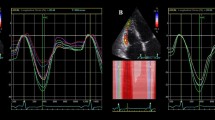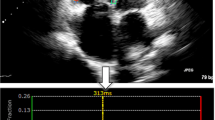Abstract
The aim of this study was to design a new approach for the acquisition of regional radial strain from the middle portion of the interventricular septum. We designed and wrote a program in Matlab (computer-assisted method) for use on a personal computer so that the septum thickness throughout the cardiac cycle could be measured instantaneously. Computer-assisted and conventional manual methods were used on the same 2D echocardiography image frames. Then, real-time 2D color Doppler myocardial imaging and conventional 2D imaging of the septum walls of 12 healthy participants at rest using apical four-chamber view were acquired. Wall thickness was measured using both the computerized program and velocity data used for tracking the segment and intensity line profile modification automatically. Then, the radial strain was estimated. Bland-Altman statistical analysis shows good agreement between the computer-assisted method and conventional manual method. The average of the peak and mean radial strains from the mid-septum of 12 healthy participants were 63.5 ± 10.7 and 31.7 ± 7.5%, respectively. We introduced a simple approach that is capable of radial strain estimation of the septum wall, which cannot be measured by current Doppler based methods in echocardiography systems.







Similar content being viewed by others
References
Bland JM, Altman DG (1986) Statistical methods for assessing agreement between two methods of clinical measurement. Lancet 1:307–310
Boettler P, Claus P, Herbots L, McLaughlin M, D’hooge J, Bijnens B, Ho SY, Kececioglu D, Sutherland GR (2005) New aspects of the ventricular septum and its function: an echocardiographic study. Heart 91:1343–1348
Bovik AC, Desai MD (2000) Handbook of image and video processing, section Ι and ΙΙ. 1st edn, chap 2. Academic, Texas, pp 21–53
Cain P, Short L, Baglin T, Case C, Bosch HG, Marwick TH (2002) Development of a fully quantitative approach to the interpretation of stress echocardiography using radial and longitudinal myocardial velocities. J Am Soc Echocardiogr 15:759–767
D’hooge J, Konofagou E, Jamal F, Heimdal A, Barrios L, Thoen J, Van de Werf F, Sutherland G, Suetens P (2002) Two-dimensional ultrasonic strain rate measurement of the human heart in vivo. IEEE Trans Ultrason Ferroelectr Freq Control 49:281–286
Davidavicius G, Misonis N, Grabauskien V (2003) Quantification of regional myocardial function following acute myocardial infarction by ultrasonic strain rate and strain imaging. Semin Cardiol 9:46–51
Dhooge J, Heimdal A, Jamal F, Kukulski T, Bijnens B, Rademakers F, Hatle L, Suetens P, Sutherland GR (2000) Regional strain and strain rate measurements by cardiac ultrasound: principles, implementation and limitations. Eur J Echocardiogr 1:154–170
Dhooge J, Rabben SI, Claus P, Irgens F, Thoen J, Van de Werf F, Suetens PA (2003) A virtual environment for the evaluation, validation, and optimization of strain and strain rate imaging. IEEE ultrasonics symposium, pp 1840–1842
Dohi K, Suffoletto MS, Schwartzman D, Ganz L, Pinsky MR, Gorcsan J (2005) Utility of echocardiographic radial strain imaging to quantify left ventricular dissynchrony and predict acute response to cardiac resynchronization therapy. Am J Cardiol 96:112–116
Galderisi M, Mele D, Marino PN (2005) Quantitation of stress echocardiography by tissue Doppler and strain rate imaging: a dream come true? Ital Heart J 6:9–20
Gilman G, Khandheria BK, Hagen ME, Abraham TP, Seward JB, Belohlavek M (2004) Strain rate and strain: a step-by-step approach to image and data acquisition. J Am Soc Echocardiogr 17:1101–1120
Hasegawa T, Nakatani S, Maruo T, Tanaka N, Kim J, Hanatani A, Hashimura K, Yasumura Y, Yamagishi M, Kitakaze M, Miyatake K (2003) Quantitative assessment of wall motion using myocardial strain. J Echocardiogr 1:23–28
Hatle L, Sutherland GR (2000) Regional myocardial function: a new approach. Eur Heart J 21:1337–1357
Heimdal A, Støylen A, Torp H, Skjærpe T (1998) Real- time strain rate imaging of the left ventricle by ultrasound. J Am Soc Echocardiogr 11:1013–1009
Henry WL, DeMaria A, Gramiak R, King DL, Kisslo J A, Popp RL, Sahn DJ, Schiller NB, Tajik A, Teichholz LE, Weyman AE (1980) Report of the American Society of Echocardiography committee on nomenclature and standards in 2D echocardiography. Circulation 62:212–215
Ikonomatakis N, Plataniotis KN, Zervakis M, Venetsanopoulos AN (1997) Region growing and region merging image segmentation. In: Proceedings of the 13th conference on digital signal processing, vol 1, pp 299–302
Khojastepour MA, Aazhang B, Baraniuk RG (2004) Contraction, smoothness, and low-pass filtering. IEEE international conference on acoustics, speech, and signal processing (ICASSP 2004), Montreal, pp 897–900
Kowalski M, Kukulski T, Jamal F, D’hooge J, Weidemann F, Rademakers F, Bijnens B, Hatle L, Sutherland GR (2001) Can natural strain and strain rate quantify regional myocardial deformation? A study in healthy subjects. Ultrasound Med Biol 27:1087–1097
Kukulski T, Jamal F, D’hooge J, Bijnens B, De Scheerder I, Sutherland GR (2002) Acute changes in systolic and diastolic events during clinical coronary angioplasty: a comparison of regional velocity, strain rate, and strain measurement. J Am Soc Echocardiogr 15:1–12
Lang RM, Bierig M, Devereux RB, Flachskampf FA, Foster E, Pellikka PA, Picard MH, Roman MJ, Seward J, Shanewise JS, Solomon SD, Spencer KT, Sutton MS, Stewart WJ (2005) Recommendations for chamber quantification: a report from the American Society of Echocardiography’s guidelines and standards committee and the chamber quantification writing group, developed in conjunction with the European Association of Echocardiography, a branch of the European Society of Cardiology. J Am Soc Echocardiogr 18:1440–1463
Mancas M, Gossellin B, Macq B (2005) Segmentation using a region growing thresholding. In: Proceedings of the electronic imaging conference of the International Society for Optical Imaging, San Jose, SPIE/EI:388–398
Marwick TH (2006) Measurement of strain and strain rate by echocardiography: ready for prime time? J Am Coll Cardiol 47:1313–1327
Moladoust H, Mokhtari-Dizaji M, Ojaghi-Haghighi Z, Noohi F, Khaledifar A, Grailu H (2007) Determination of instantaneous interventricular septum wall thickness by processing sequential 2D echocardiographic images. Pak J Biol Sci 10:454–461
Pislaru C, Abraham TP, Belohlavek M (2002) Strain and strain rate echocardiography. Curr Opin Cardiol 17:443–454
Smith SW (2003) Digital signal processing. A practical guide for engineers and scientists. Moving average filters, 1st edn, chap 15. Newnes, USA, pp 277–285
Sutherland GR, Salvo GD, Claus P, D’hooge J, Bijnens B (2004) Strain and strain rate imaging: a new clinical approach to quantifying regional myocardial function. J Am Soc Echocardiogr 17:788–802
Urheim S, Edvardsen T, Torp H, Angelsen B, Smiseth OA (2000) Myocardial strain by Doppler echocardiography: validation of a new method to quantify regional myocardial function. Circulation 102:1158–1164
Voigt JU, Lindenmeier G, Exner B, Regenfus M, Werner D, Reulbach U, Nixdorff U, Flachskampf FA, Daniel WG (2003) Incidence and characteristics of segmental postsystolic longitudinal shortening in normal, acutely ischemic, and scarred myocardium. J Am Soc Echocardiogr 16:415–23
Author information
Authors and Affiliations
Corresponding author
Rights and permissions
About this article
Cite this article
Moladoust, H., Mokhtari-Dizaji, M., Ojaghi-Haghighi, Z. et al. Radial strain assessment of the interventricular septum wall by a new technique in healthy subjects. Med Bio Eng Comput 45, 855–862 (2007). https://doi.org/10.1007/s11517-007-0222-x
Received:
Accepted:
Published:
Issue Date:
DOI: https://doi.org/10.1007/s11517-007-0222-x




